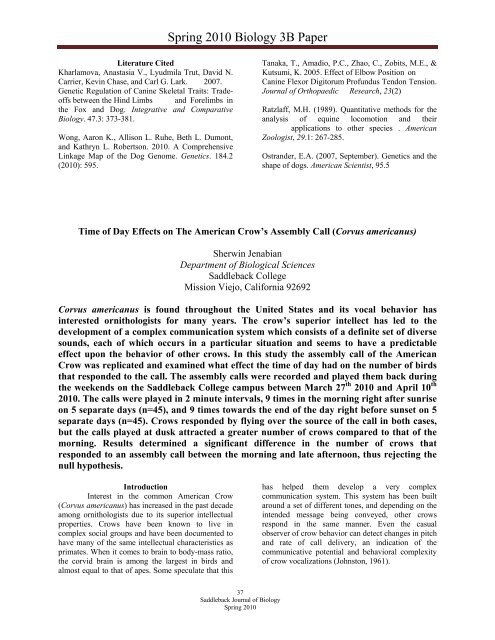Saddleback Journal of Biology - Saddleback College
Saddleback Journal of Biology - Saddleback College
Saddleback Journal of Biology - Saddleback College
Create successful ePaper yourself
Turn your PDF publications into a flip-book with our unique Google optimized e-Paper software.
Spring 2010 <strong>Biology</strong> 3B Paper<br />
Literature Cited<br />
Kharlamova, Anastasia V., Lyudmila Trut, David N.<br />
Carrier, Kevin Chase, and Carl G. Lark. 2007.<br />
Genetic Regulation <strong>of</strong> Canine Skeletal Traits: Trade<strong>of</strong>fs<br />
between the Hind Limbs and Forelimbs in<br />
the Fox and Dog. Integrative and Comparative<br />
<strong>Biology</strong>. 47.3: 373-381.<br />
Wong, Aaron K., Allison L. Ruhe, Beth L. Dumont,<br />
and Kathryn L. Robertson. 2010. A Comprehensive<br />
Linkage Map <strong>of</strong> the Dog Genome. Genetics. 184.2<br />
(2010): 595.<br />
Tanaka, T., Amadio, P.C., Zhao, C., Zobits, M.E., &<br />
Kutsumi, K. 2005. Effect <strong>of</strong> Elbow Position on<br />
Canine Flexor Digitorum Pr<strong>of</strong>undus Tendon Tension.<br />
<strong>Journal</strong> <strong>of</strong> Orthopaedic Research, 23(2)<br />
Ratzlaff, M.H. (1989). Quantitative methods for the<br />
analysis <strong>of</strong> equine locomotion and their<br />
applications to other species . American<br />
Zoologist, 29.1: 267-285.<br />
Ostrander, E.A. (2007, September). Genetics and the<br />
shape <strong>of</strong> dogs. American Scientist, 95.5<br />
Time <strong>of</strong> Day Effects on The American Crow’s Assembly Call (Corvus americanus)<br />
Sherwin Jenabian<br />
Department <strong>of</strong> Biological Sciences<br />
<strong>Saddleback</strong> <strong>College</strong><br />
Mission Viejo, California 92692<br />
Corvus americanus is found throughout the United States and its vocal behavior has<br />
interested ornithologists for many years. The crow’s superior intellect has led to the<br />
development <strong>of</strong> a complex communication system which consists <strong>of</strong> a definite set <strong>of</strong> diverse<br />
sounds, each <strong>of</strong> which occurs in a particular situation and seems to have a predictable<br />
effect upon the behavior <strong>of</strong> other crows. In this study the assembly call <strong>of</strong> the American<br />
Crow was replicated and examined what effect the time <strong>of</strong> day had on the number <strong>of</strong> birds<br />
that responded to the call. The assembly calls were recorded and played them back during<br />
the weekends on the <strong>Saddleback</strong> <strong>College</strong> campus between March 27 th 2010 and April 10 th<br />
2010. The calls were played in 2 minute intervals, 9 times in the morning right after sunrise<br />
on 5 separate days (n=45), and 9 times towards the end <strong>of</strong> the day right before sunset on 5<br />
separate days (n=45). Crows responded by flying over the source <strong>of</strong> the call in both cases,<br />
but the calls played at dusk attracted a greater number <strong>of</strong> crows compared to that <strong>of</strong> the<br />
morning. Results determined a significant difference in the number <strong>of</strong> crows that<br />
responded to an assembly call between the morning and late afternoon, thus rejecting the<br />
null hypothesis.<br />
Introduction<br />
Interest in the common American Crow<br />
(Corvus americanus) has increased in the past decade<br />
among ornithologists due to its superior intellectual<br />
properties. Crows have been known to live in<br />
complex social groups and have been documented to<br />
have many <strong>of</strong> the same intellectual characteristics as<br />
primates. When it comes to brain to body-mass ratio,<br />
the corvid brain is among the largest in birds and<br />
almost equal to that <strong>of</strong> apes. Some speculate that this<br />
has helped them develop a very complex<br />
communication system. This system has been built<br />
around a set <strong>of</strong> different tones, and depending on the<br />
intended message being conveyed, other crows<br />
respond in the same manner. Even the casual<br />
observer <strong>of</strong> crow behavior can detect changes in pitch<br />
and rate <strong>of</strong> call delivery, an indication <strong>of</strong> the<br />
communicative potential and behavioral complexity<br />
<strong>of</strong> crow vocalizations (Johnston, 1961).<br />
37<br />
<strong>Saddleback</strong> <strong>Journal</strong> <strong>of</strong> <strong>Biology</strong><br />
Spring 2010

















